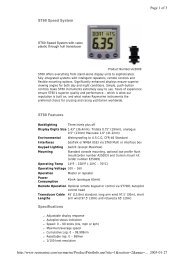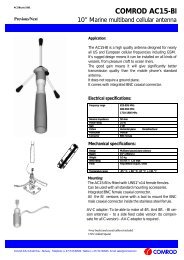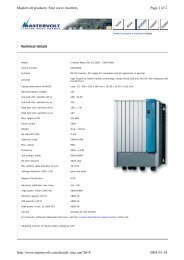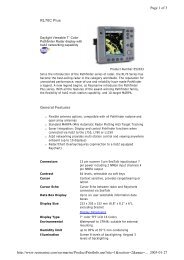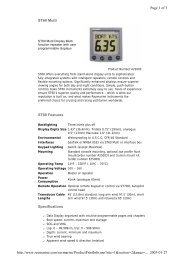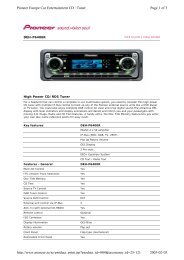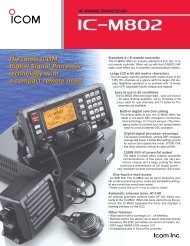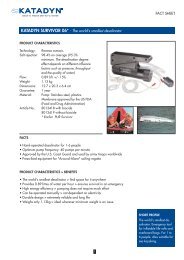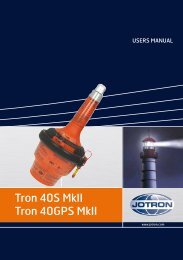Users Manual Tron SART.pdf - Jotron
Users Manual Tron SART.pdf - Jotron
Users Manual Tron SART.pdf - Jotron
Create successful ePaper yourself
Turn your PDF publications into a flip-book with our unique Google optimized e-Paper software.
1 GENERAL DESCRIPTION<br />
<strong>Tron</strong> <strong>SART</strong> is emergency equipment consisting of:<br />
1.<strong>Tron</strong> <strong>SART</strong> radar transponder.<br />
3. Mounting rope for life rafts / life boats.<br />
The 9 GHz radar transponder type <strong>Tron</strong> <strong>SART</strong> is developed by <strong>Jotron</strong> AS to meet the regulations and rules<br />
for use on vessels and life rafts in the maritime service.<br />
<strong>Tron</strong> <strong>SART</strong> meets the specifications for 9 GHz radar transponders for use in search and rescue operations<br />
at sea.<br />
The operating range of the <strong>Tron</strong> <strong>SART</strong> is up to 30 nautical miles, depending on the height of the electronic<br />
unit and the radar height of the search and rescue unit (sea or airborne).<br />
With a radar height of 20m and the <strong>Tron</strong> <strong>SART</strong> placed at 1m above sea level, the range will be up to 10<br />
nautical miles.<br />
<strong>Tron</strong> <strong>SART</strong> is buoyant, however to obtain maximum performance the transponder should be placed in a<br />
vertical position and as high up as possible in order to achieve maximum coverage.<br />
Several mounting brackets and mounting aids are developed to ease a correct mounting and use of the<br />
radar transponder.<br />
The purpose of the <strong>Tron</strong> <strong>SART</strong> is to perform a secondary alarm when search and rescue units are searching<br />
for a life raft / lifeboat in distress. The <strong>Tron</strong> <strong>SART</strong> will help the units to pinpoint exactly where the<br />
distressed boat is located in a larger area. This is done with the help of the radar on the searching ship or<br />
helicopter.<br />
When the <strong>Tron</strong> <strong>SART</strong> is interrogated (hit) by a radar signal, it will immediately start to transmit a number<br />
of sweeps covering the complete maritime 3 cm radar band.<br />
These sweeps are detected on the radar screen and are used to navigate directly towards the distressed life<br />
raft, for details on radar display see chapter 5.3.<br />
Maximum distance to a ship will normally be about 10 nm and approximately 30nm to a helicopter,<br />
dependent on the helicopters altitude. The transponder will not give any alarms further away than this.<br />
The primary alarm will usually be an Emergency Position Indicating Radio Beacon (EPIRB) or distress<br />
call on VHF / HF - manual or via digital selcall.<br />
The <strong>Tron</strong> <strong>SART</strong> should be activated immediately after the EPIRB has been started or by instructions from<br />
the rescue control centre.<br />
The batteries of the <strong>Tron</strong> <strong>SART</strong> will last at least 96 hours in standby after activation and then minimum<br />
8 hours of continuous operation.<br />
10 92478_UM_ <strong>SART</strong>_ F



